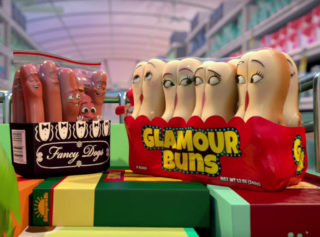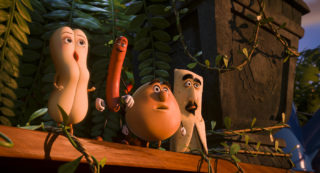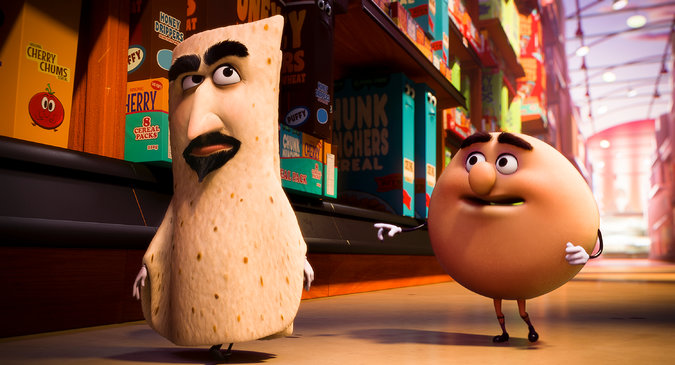Sausage Party started out as a joke, according to Conrad Vernon, director of the Sony Pictures computer-animated film. Whenever Jonah Hill and Seth Rogen were asked what their next project was, they’d say “Sausage Party.” Then one night, the two—along with writer Evan Goldberg—actually started to think about what that movie would be. They started riffing on ideas about a grocery store where the sausages got out of their package at night to desperately seek buns out to have sex.
The end result was a $19 million R-rated comedy that earned over $140 million at the box office. Vernon, who spoke at the VIEW Conference in Turin, Italy, talked to [a]listdaily about the impact that success is already having on Hollywood in this exclusive interview.
 How challenging was it to convince Hollywood to have an R-rated computer animated movie?
How challenging was it to convince Hollywood to have an R-rated computer animated movie?
Extremely challenging. Three years’ worth of challenging, and pretty much striking out at every major studio in Hollywood. We went everywhere. We thought people would just be clamoring for this. We had Seth Rogen and Jonah Hill promising to star in it. We had Seth Rogen and Evan Goldberg writing it. We had my good friend and co-director Greg Tiernan, whose Nitrogen Studios was on board to animate it. All we needed was the thumbs up and some money and we were ready to go. We would pitch it, and people would laugh and crack up and then say, “I’m sorry, we’re not doing this.” We did this over and over again for about three years.
What role did advances in technology play in allowing you guys to make the movie at a lower budget?
We used all out-of-the-box technology and software and programs. The major studios have major R&D departments that will figure out how to make things better and push technology further. We just wanted to make sure we made it look good. All the advances the studios had made over the years definitely furthered the off-the-shelf software, so it got to a point where you could make the animation look good and the lighting beautiful. All the artistic elements were solid, and then we could make the movie look really good without having to create any new technology.
How did you go about creating these characters?
One of the great things about being able to do it with food products in a grocery store was that everything was a box or a jar, so all we had to do was slap a face on a box or a jar. And then the main characters were a taco shell, a hot dog bun, a sausage; they didn’t have hair. We didn’t want them to look humanistic with knees and elbows and stuff. It started to look grotesque when you did that. So we basically went right back to the old 1930s Mickey Mouse cartoons, with the rubber hose arms and legs and giant funny Mickey Mouse gloves and big flappy Mad Magazine Don Martin feet and make it as cartoony as we can. That did two things: it simplified the rigs, but it also let us explore doing more of a Bob Campett Warner Bros. type of style where we could have wiggly arms and stuff like that—and really get more cartoony and animated with it rather than having to try and make beautifully designed characters act as real as possible.
What did the R-rating open up for this film?
We never looked at it as, “We have to write this animated and then because it’s R we have to make it as dirty as possible.” It is dirty, of course, I’ll admit that, but we didn’t try to make it dirty so that it would be rated R. We just basically wrote a movie that made us laugh and because we have dirty minds to a certain extent—that stuff made us laugh really hard. We didn’t have to cut it out or sanitize it because it was rated R, so we could do whatever we wanted. We were sincerely trying to make a funny movie where you cared about the characters and it had a good story. The fact that we did it with food dictated that we do it in CG because we weren’t going to dress up actors in costumes and do this in live action.
Did the MPAA have any issues with the film?
The fact that it was actual food helped. None of them are wearing clothes to begin with. I mean, we had a food orgy. The MPAA just drew a line at the fluids. They said no chocolate syrup, no ranch dressing, no mustard squirting out. They just said no fluids at all, and so we do have a version of the film where we do use the fluids quite a bit.
What impact do you feel this film’s success will have on broadening computer animation?
From day 1, we always hoped we were going to kick down the door of the idea that animation is only for kids and that there wasn’t an audience for it unless they’re dragged to it by their child. People go see these movies because they like them. I remember seeing Shrek 2 at 10:30 pm and the audience was filled with adults. I always knew there was an audience for it, but no one really wanted to take the risk that no one would show up. I hope that we’ve shown that there is an audience, that it is viable financially, and that it will give a lot of other animators out there—who might have ideas for films that don’t fit in this little box that the animation industry has been forced into over the years—the chance to tell their stories and make them any way they want.
When you were mapping this out, were you thinking bigger picture in terms of sequels or where these characters could go next?
Yeah, we started talking about a sequel, what it would be about, and what would take place. We finally realized that we’re not going to do a sequel unless we have a damn good idea for it. That being said, it doesn’t mean we don’t want to make more R-rated animated films. We probably will. We have a ton of ideas for other R-rated animated films even if we don’t make a sequel for this one.
 We’ve seen a lot of animated films turned into video games. What would the Sausage Party video game be?
We’ve seen a lot of animated films turned into video games. What would the Sausage Party video game be?
I’m sure we would come up with something you have to collect in each aisle and then go to a place where you would fight a boss. Then, at the end of the game, there will probably be sex between all the food. It would be pretty funny if we actually used 8-bit graphics and the old Atari 2600 sound effects for the orgy. I would love to see Sausage Party turned into a video game. It would be fun. I’m a gamer, so I would like to play it.
We’re seeing Hollywood start to explore virtual reality. What are your thoughts about what that new medium is opening up for storytelling, especially comedy?
I’ve tried VR—it’s unbelievable. The trippy side of me says that I just want to put those goggles on and be in a place. I’ve done it where this guy turned on a little fan while I was in virtual reality and it felt like this beautiful breeze over me because I was on a ship on the water. So it totally trips your brain up.
The key is in making sure that you roll it out the best way it could possibly be rolled out. Don’t jump straight into trying to do something that hasn’t been thought about deeply enough. If you’re instantly going to put movies into VR without understanding it and how it affects people, it might hit the public the wrong way. But if you do VR more like a video game, where people can control how fast things move and people can march forward, backward, or look around and experience it and get used to it, then people are going to be intrigued by it and they’re going to want more. That’s when you can pounce on doing something more with it. Let the technology guide you to where it needs to be, instead of forcing it into something.

